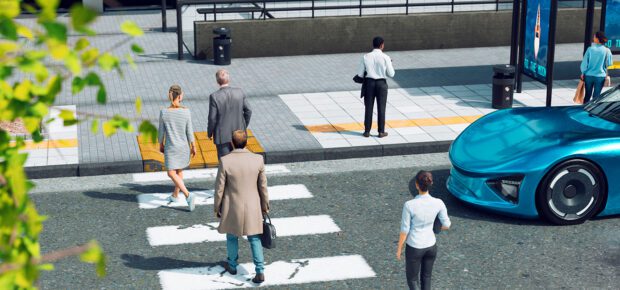November 16, 2023
Around the world, there are more than 1.3 million fatal car collisions each year. The total includes vulnerable road users such as cyclists, pedestrians and motorcyclists. IEEE Member Bilin Aksun-Guvenc believes that these numbers can be significantly reduced, and pedestrian safety increased, with a device that most people carry in their pockets: the smartphone.
Aksun-Guvenc’s research uses smartphone data to inform drivers and autonomous vehicles of collision risks.
Tell us about the system you are working on.
Smartphones are equipped with an array of sensors — including GPS, accelerometers, gyros, step counters and light sensors — that can measure a vulnerable road user’s motion. With a smartphone app, this data can pinpoint a user’s location, future position and travel direction, then broadcast it to vehicles via an over-the-air connection.
Why wouldn’t carmakers just use machine vision to identify pedestrians and other vulnerable road users?
Carmakers do use machine vision with existing vehicle cameras for protection, but these systems can’t see around corners or through barriers since they need a line-of-sight to detect users. Vision sensors are also affected by lighting and weather conditions; for instance, some lane-keeping assist systems deactivate in the rain. Communication systems, less hindered by these conditions, could complement machine vision to improve user tracking.
So, does the pedestrian need a special app on their smartphone? Does the driver need anything? Could this become a standard feature in cars?
The same app could operate on the driver’s smartphone as well as on the vulnerable road user’s device. Since many users already have smartphones, integrating this technology into production vehicles would be straightforward. This system, especially with level 2 automation vehicles, could significantly enhance collision avoidance measures.
How does the user’s phone communicate with the vehicle?
Low-energy Bluetooth is a viable option due to its minimal power consumption. It allows for ”advertising mode,” wherein the phone broadcasts data without pairing, maintaining user privacy. That said, the technology is agnostic with regard to communication technology. Cellular technologies could also serve this purpose without significant latency impacts.
Would it be possible to incorporate this system into devices that aren’t phones?
Absolutely, and it’s recommended. Construction workers could carry beacons similar to digital safety vests, while cyclists could incorporate the system into GPS devices. This simple beacon approach would benefit children who don’t own smartphones.
What challenges have you faced in designing this system?
Real-world deployment with many users is necessary to refine our approach and evaluate its full potential. Issues like smartphone GPS accuracy and communication latency can lead to false positives and negatives, but these are resolvable problems.
Are there any other applications for this system?
The system’s communication features could aid in various scenarios, such as guiding food delivery robots on university campuses which often block access ramps while waiting to cross streets. Better vehicle communication could mitigate this. Additionally, vehicle-to-vehicle cooperation could enhance urban mobility, potentially replacing physical traffic signals at intersections.
Learn more: What makes an autonomous vehicle safe? How safe should we expect them to be? The IEEE Standards Association has worked to establish best safety practices for autonomous vehicles based on car following, road sharing, pedestrian situations, intersection scenarios and visibility issues including consideration of rules of the road and their regional and/or temporal dependencies.






 AI Through Our Ages
AI Through Our Ages Liquid Infrastructure: Our Planet's Most Precious Resource
Liquid Infrastructure: Our Planet's Most Precious Resource The Impact of Technology in 2025
The Impact of Technology in 2025 Quantum and AI: Safeguards or Threats to Cybersecurity?
Quantum and AI: Safeguards or Threats to Cybersecurity? Why AI Can't Live Without Us
Why AI Can't Live Without Us Bits, Bytes, Buildings and Bridges: Digital-Driven Infrastructure
Bits, Bytes, Buildings and Bridges: Digital-Driven Infrastructure Impact of Technology in 2024
Impact of Technology in 2024 Emerging AI Cybersecurity Challenges and Solutions
Emerging AI Cybersecurity Challenges and Solutions The Skies are Unlimited
The Skies are Unlimited Smart Cities 2030: How Tech is Reshaping Urbanscapes
Smart Cities 2030: How Tech is Reshaping Urbanscapes Impact of Technology 2023
Impact of Technology 2023 Cybersecurity for Life-Changing Innovations
Cybersecurity for Life-Changing Innovations Smarter Wearables Healthier Life
Smarter Wearables Healthier Life Infrastructure In Motion
Infrastructure In Motion The Impact of Tech in 2022 and Beyond
The Impact of Tech in 2022 and Beyond Cybersecurity, Technology and Protecting Our World
Cybersecurity, Technology and Protecting Our World How Technology Helps us Understand Our Health and Wellness
How Technology Helps us Understand Our Health and Wellness The Resilience of Humanity
The Resilience of Humanity Harnessing and Sustaining our Natural Resources
Harnessing and Sustaining our Natural Resources Creating Healthy Spaces Through Technology
Creating Healthy Spaces Through Technology Exceptional Infrastructure Challenges, Technology and Humanity
Exceptional Infrastructure Challenges, Technology and Humanity The Global Impact of IEEE's 802 Standards
The Global Impact of IEEE's 802 Standards Scenes of our Cyber Lives: The Security Threats and Technology Solutions Protecting Us
Scenes of our Cyber Lives: The Security Threats and Technology Solutions Protecting Us How Millennial Parents are Embracing Health and Wellness Technologies for Their Generation Alpha Kids
How Millennial Parents are Embracing Health and Wellness Technologies for Their Generation Alpha Kids Space Exploration, Technology and Our Lives
Space Exploration, Technology and Our Lives Global Innovation and the Environment
Global Innovation and the Environment How Technology, Privacy and Security are Changing Each Other (And Us)
How Technology, Privacy and Security are Changing Each Other (And Us) Find us in booth 31506, LVCC South Hall 3 and experience the Technology Moon Walk
Find us in booth 31506, LVCC South Hall 3 and experience the Technology Moon Walk Virtual and Mixed Reality
Virtual and Mixed Reality How Robots are Improving our Health
How Robots are Improving our Health IEEE Experts and the Robots They are Teaching
IEEE Experts and the Robots They are Teaching See how millennial parents around the world see AI impacting the lives of their tech-infused offspring
See how millennial parents around the world see AI impacting the lives of their tech-infused offspring Take the journey from farm to table and learn how IoT will help us reach the rising demand for food production
Take the journey from farm to table and learn how IoT will help us reach the rising demand for food production Watch technical experts discuss the latest cyber threats
Watch technical experts discuss the latest cyber threats Explore how researchers, teachers, explorers, healthcare and medical professionals use immersive technologies
Explore how researchers, teachers, explorers, healthcare and medical professionals use immersive technologies Follow the timeline to see how Generation AI will be impacted by technology
Follow the timeline to see how Generation AI will be impacted by technology Learn how your IoT data can be used by experiencing a day in a connected life
Learn how your IoT data can be used by experiencing a day in a connected life Listen to technical experts discuss the biggest security threats today
Listen to technical experts discuss the biggest security threats today See how tech has influenced and evolved with the Games
See how tech has influenced and evolved with the Games Enter our virtual home to explore the IoT (Internet of Things) technologies
Enter our virtual home to explore the IoT (Internet of Things) technologies Explore an interactive map showcasing exciting innovations in robotics
Explore an interactive map showcasing exciting innovations in robotics Interactively explore A.I. in recent Hollywood movies
Interactively explore A.I. in recent Hollywood movies Get immersed in technologies that will improve patients' lives
Get immersed in technologies that will improve patients' lives